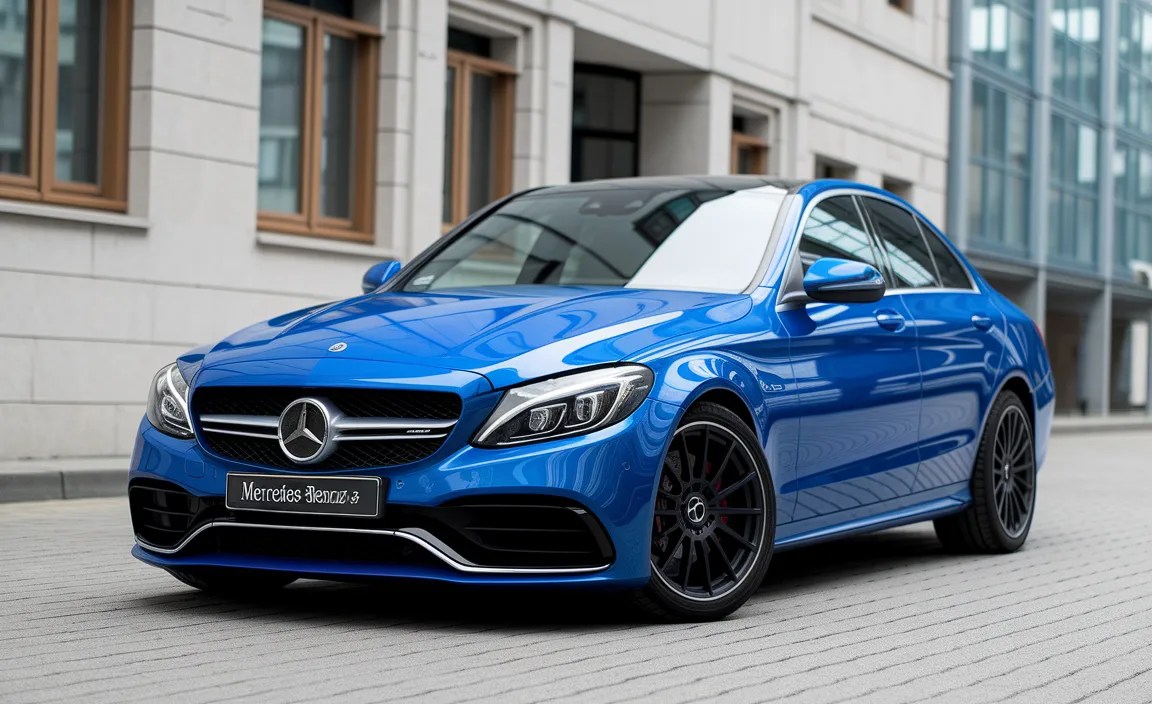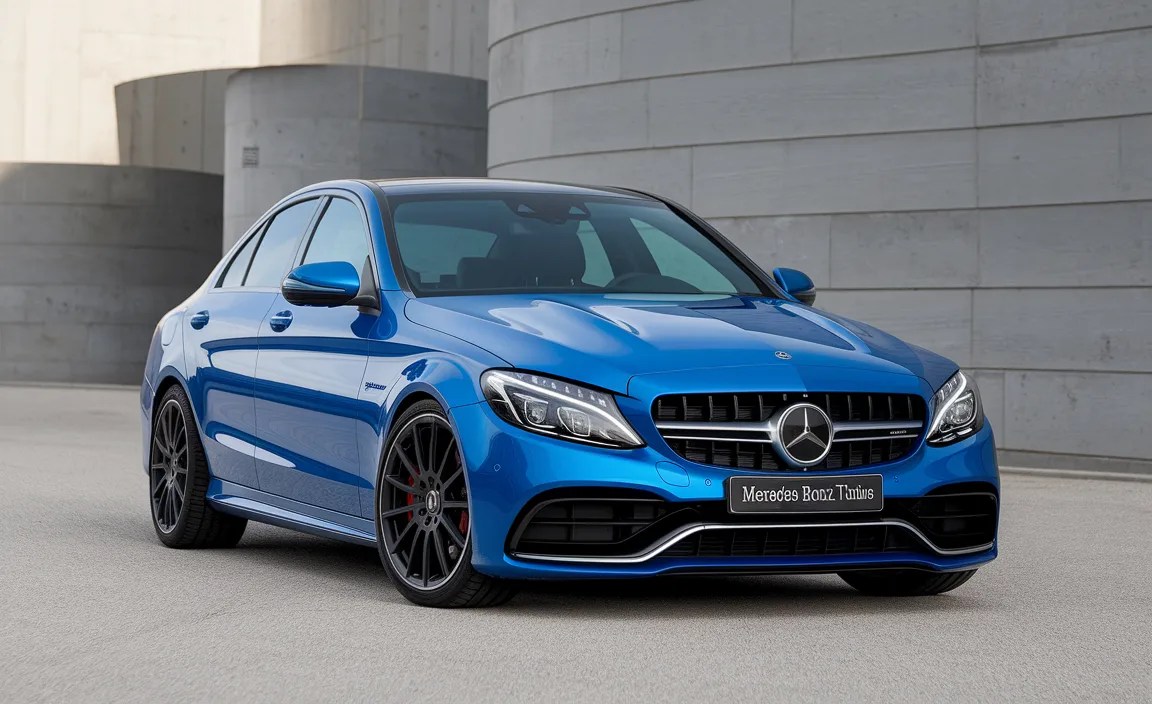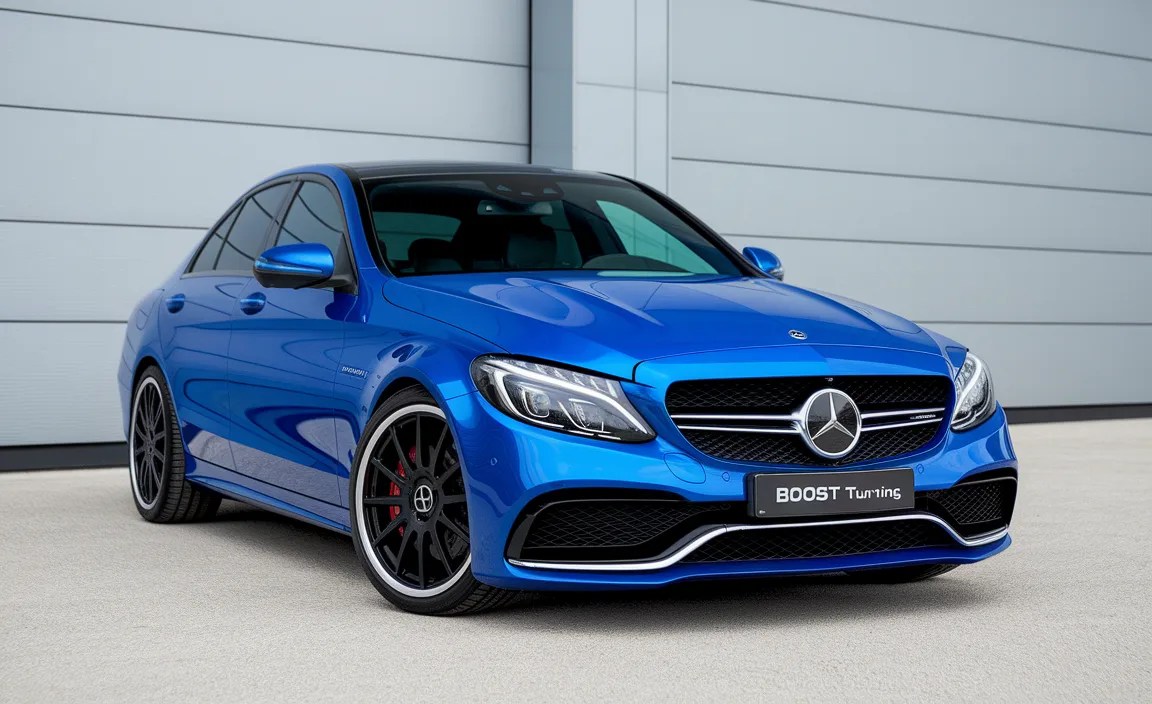Mercedes-Benz C Class Boost Tuning: Effortless Power
C Class boost tuning can unlock impressive horsepower gains, making your Mercedes-Benz C-Class feel significantly quicker and more responsive. It’s a popular modification for enthusiasts seeking a noticeable performance upgrade with relatively straightforward methods, often achievable without extensive mechanical knowledge.
When you first consider enhancing your Mercedes-Benz C-Class’s performance, the idea of “boost tuning” might sound complex. But don’t worry, it’s more accessible than you might think! Many C-Class owners dream of that extra surge of power, that satisfying push back into the seat. Fortunately, achieving this often involves understanding and optimizing the engine’s forced induction system – its “boost.”
This isn’t just about raw power; it’s about making your drive more exhilarating and responsive. We’ll demystify C Class boost tuning, showing you how to achieve effortless power to transform your driving experience. Get ready to learn about what makes your C-Class tick and how to unlock its hidden potential.

Understanding Boost Tuning for Your C-Class
At its core, “boost tuning” for your C-Class involves optimizing how the engine takes in air. Most modern C-Class vehicles, especially those with turbocharged engines (often designated by “CGI” or simply by their engine nomenclature like C300, C43, etc.), rely on a turbocharger to force more air into the combustion chambers.

More air means more fuel can be burned, leading to a significant increase in power. Boost tuning essentially fine-tunes the engine’s computer (ECU – Engine Control Unit) to manage this forced induction more effectively. This can involve:
Increasing Turbocharger Boost Pressure: Gently raising the maximum pressure the turbocharger produces.
Optimizing Air-Fuel Ratios: Ensuring the perfect balance of air and fuel for optimal combustion.
Adjusting Ignition Timing: Fine-tuning when the spark plug ignites the fuel for maximum power and efficiency.
Modifying Throttle Response: Making the accelerator pedal more sensitive for quicker reactions.
The goal is to achieve “effortless power” – meaning the car feels stronger and more responsive across the rev range, making everyday driving and spirited excursions more enjoyable.
Why Boost Tuning is Popular with C-Class Owners
Several factors make C Class boost tuning a hit among Mercedes-Benz enthusiasts:
Significant Performance Gains: It’s one of the most effective ways to noticeably increase horsepower and torque.
Enhanced Driving Experience: The car feels livelier, accelerates faster, and can be more engaging to drive.
Relatively Affordable: Compared to major engine overhauls or full turbo upgrades, tuning can be a cost-effective performance boost.
Accessibility: Modern tuning solutions, like ECU remapping or piggyback modules, are sophisticated and often designed for plug-and-play installation.
Preserves Luxury Feel: Done correctly, boost tuning enhances performance without sacrificing the refined comfort and luxury Mercedes-Benz is known for.
Types of C Class Boost Tuning Methods
When we talk about boost tuning your C-Class, there are a few primary methods you’ll encounter. Each has its own pros, cons, and complexity level, making it important to understand them before you decide.

1. ECU Remapping (Chiptuning)
This is perhaps the most common and direct method of boost tuning. It involves modifying the software within your car’s Engine Control Unit (ECU).
How it Works: A tuner accesses the ECU’s factory map and adjusts various parameters related to engine performance, particularly turbocharger boost pressure, fuel delivery, and ignition timing. This can be done by:
Bench Flashing: The ECU is removed from the car and connected to specialized equipment.
OBD-II Port Flashing: A cable is plugged into the car’s diagnostic port (OBD-II) to upload new software directly. This is the most common method for modern vehicles.
Pros:
Can offer the most comprehensive and integrated performance gains.
Potential for significant power increases.
Once programmed, there are no physical components to install or manage.
Cons:
Requires specialized knowledge and equipment.
Can be more expensive upfront.
If not done by a reputable tuner, can potentially lead to engine damage or voiding warranties.
Requires access to the ECU.
Ideal For: Owners looking for the most optimized performance tune and who are comfortable working with professional tuning services.
2. Piggyback Tuning Modules
These devices offer a less invasive way to modify your C-Class’s performance. They “piggyback” onto existing sensors and the ECU.
How it Works: A module is installed between the ECU and key sensors (like boost pressure sensors, camshaft position sensors, etc.). It intercepts the signals, alters them slightly to trick the ECU into commanding higher boost, and then sends the modified signal.
Pros:
Generally easier to install than full ECU remapping.
Often removable, making it easier to revert to stock settings, which can be beneficial for servicing or resale.
Can be more affordable than a custom dyno tune.
Cons:
May not offer the same level of fine-tuning as a full ECU remap.
Can sometimes lead to check engine lights if not perfectly calibrated.
Performance gains might be less pronounced compared to a dedicated remap.
Ideal For: DIY enthusiasts who want a reversible performance upgrade and are comfortable with basic under-hood installations.
3. Performance Tuning Boxes (Less Common for “Boost” Specific Tuning)
While often marketed for performance, many “tuning boxes” available online for a low price are less sophisticated and might not specifically target boost optimization effectively. They might simply alter sensor readings without deep ECU integration. For true boost tuning, the first two methods are generally more effective and recommended.
Before You Tune: Essential Pre-Tuning Checks
Before diving into C Class boost tuning, it’s crucial to ensure your C-Class is in peak condition. A tune pushes the engine harder, so any existing issues can be exacerbated.
1. Thorough Vehicle Inspection
Engine Health: Is the engine running smoothly? Are there any unusual noises? A compression test can reveal internal health.
Cooling System: Overheating is a major enemy of turbocharged engines. Check coolant levels, radiator integrity, hoses, and the water pump.
Intake System: Inspect all vacuum hoses, intercooler piping, and seals for leaks. Leaks disrupt boost pressure and can lead to performance loss or engine damage.
Exhaust System: Ensure there are no leaks before the turbocharger, as these reduce efficiency. Check for any blockages that could impede exhaust flow.
Spark Plugs & Coils: Worn spark plugs or faulty ignition coils can cause misfires, especially under increased load from tuning.
Fuel System: Ensure the fuel pump and injectors are in good working order and can deliver sufficient fuel for the increased air intake.
2. Maintenance Records
Review your Mercedes-Benz’s service history. Have all scheduled maintenance been performed? This includes oil changes (using the correct synthetic oil), filter replacements (air, oil, cabin), and fluid checks.
3. Understand Your Specific C-Class Model
Not all C-Class models are created equal. Engine codes, factory turbocharger specifications, and ECU types vary. Knowing your specific model (e.g., W205 C300, C43 AMG) is vital for selecting the right tuning approach and parts. You can typically find this information on the vehicle’s VIN decoder or by checking the owner’s manual.
4. Warranty Considerations
Be aware that ECU remapping or significant modifications can void your manufacturer’s warranty, especially powertrain warranties. Some tuning companies offer ‘dealer-friendly’ tunes that can be easily removed, but this is not always foolproof. Always check your warranty terms and discuss implications with your tuner.
Step-by-Step: How to Perform C Class Boost Tuning (ECU Remapping)
This guide focuses on ECU remapping, the most common and effective method for comprehensive boost tuning. Remember, this is best performed by a professional tuner.

Materials & Tools You’ll Likely Need (for your tuner):
Laptop with tuning software
OBD-II programming cable (specific to Mercedes-Benz protocols)
Battery stabilizer (to ensure consistent power during flashing)
Diagnostic tools (scanner for codes, live data monitoring)
Torque wrench (for any component reinstallation)
The Process:
1.Consult a Reputable Tuner: This is the most critical step. Find a tuner with a proven track record for Mercedes-Benz vehicles. They will have the expertise and specialized tools. Discuss your goals – do you want a mild improvement for daily driving or a more aggressive tune for spirited driving?
2. Initial Vehicle Assessment: The tuner will likely perform a baseline health check and a dyno run (if available) to measure your car’s current horsepower and torque. This provides a benchmark for the tuning process.
3. ECU Access:
If OBD-II Port Flashing: The tuner will connect their interface cable to your car’s OBD-II port, usually located under the dashboard.
If Bench Flashing: The ECU will be carefully removed from its location (often behind the engine or under the dash/seat) and connected directly to the tuning bench.
4. Reading the Original ECU File: The tuner reads the stock software map from your ECU. This is your car’s factory configuration.
5. Custom Map Creation or Selection:
Custom Tune: The tuner will modify the original file, adjusting boost pressure, fuel maps, ignition timing, and other parameters based on your car’s specific hardware and your driving goals. This is the preferred method for optimal results.
Off-the-Shelf (OTS) Tune: Some tuners offer pre-made maps for specific models. While convenient, a custom tune is usually superior.
6. Writing the New Map: The new, optimized software is uploaded to the ECU. This process can take anywhere from 15 minutes to over an hour, depending on the complexity and method. A battery stabilizer is crucial here to prevent power interruptions.
7. Initial Startup and Diagnostics: After flashing, the engine is started. The tuner will monitor for any immediate issues, check for diagnostic trouble codes (DTCs), and observe live engine data.
8. Post-Tune Dyno Testing (Optional but Recommended): The car is put back on the dyno to measure the new power output and verify that the tune is performing as expected. This helps ensure safety and maximize gains.
9. Test Drive: A thorough test drive is conducted in various conditions to assess drivability, throttle response, and overall performance.
10. Final Adjustments: Based on the dyno results and test drive feedback, minor adjustments can be made to the map for perfect calibration.
Enhancing C-Class Boost: Supporting Modifications
While ECU tuning is the core of C Class boost tuning, certain hardware modifications can complement it, allowing for even greater power gains and improved reliability.

1. Upgraded Intercooler
A larger, more efficient intercooler is vital. The turbocharger heats the intake air; a hotter charge is less dense and less powerful. An upgraded intercooler cools the intake air more effectively, providing denser air for the engine. This allows the ECU to inject more fuel safely and extract more power, especially under sustained boost.
Benefits: Cooler intake temperatures, more consistent power delivery, reduced risk of heat soak.
Considerations: Proper fitment, potential for increased turbo lag if airflow is restricted.
2. Performance Air Filter
A high-flow air filter allows the engine to draw in air more easily. While the gains are usually modest on their own, it can help support higher boost levels by reducing restriction in the intake path before the turbocharger.
Benefits: Slight increase in airflow, can improve engine sound.
Considerations: Choose reputable brands; some “oiled” filters can potentially harm Mass Air Flow (MAF) sensors if over-oiled.
3. Downpipes and Exhaust System
The turbocharger needs to expel exhaust gases efficiently. Upgraded downpipes (the section immediately after the turbocharger) and a less restrictive exhaust system can reduce backpressure. This helps the turbo spool up faster and maintain boost more effectively, leading to better performance.
Benefits: Faster turbo spool, more power, improved exhaust note.
Considerations: Can be expensive, potential for drone, check local emissions regulations.
4. Diverter Valves and Blow-Off Valves
Diverter Valves (DV): These recirculate excess boost pressure back into the intake system when the throttle closes. Upgraded DVs can handle higher boost pressures without leaking.
Blow-Off Valves (BOV): These vent excess boost pressure to the atmosphere, creating the familiar “psshh” sound. While less common on stock setups for luxury cars, some enthusiasts opt for them. They serve a similar purpose to DVs in managing boost.
Benefits: Improved boost holding capability, can customize turbo sounds.
Considerations: BOVs are often a cosmetic modification and may not always be ideal for MAF-sensored engines without proper recalibration. Stick with DV upgrades for most C-Class applications.
Choosing the Right Tune for Your C300 Sedan vs. C43 AMG
While the principles of boost tuning are the same, the approach and expected results can differ significantly between a C-Class sedan (like a C300) and a more performance-oriented model like the C43 AMG.

C300 Sedan (Typically 2.0L Turbocharged Inline-4)
Focus: Bringing the car closer to its potential, enhancing daily drivability, and providing a satisfying performance uplift without drastically altering its character.
Typical Gains: Expect an increase of 30-50 horsepower and 40-60 lb-ft of torque.
Tuning Approach: Often a mild to moderate ECU remap is sufficient. Supporting modifications like an upgraded intercooler can further optimize these gains and ensure consistency. The stock turbocharger is usually capable of handling a moderate boost increase.
Considerations: Reliability and comfort are paramount. The tune should feel smooth and progressive, not overly aggressive.
C43 AMG (Typically 3.0L Bi-Turbocharged V6)
Focus: Maximizing the already impressive performance. Owners often seek a more aggressive power delivery and higher peak numbers.
Typical Gains: Gains can be more substantial, potentially 50-80+ horsepower and 60-90+ lb-ft of torque, depending on the tune and supporting mods.
Tuning Approach: This often involves more aggressive boost increases, refined ignition timing, and optimized fuel maps. Supporting modifications like downpipes and a high-flow intercooler are highly recommended to manage the increased stress on the twin-turbo setup.
Considerations: The bi-turbo V6 is already a potent engine. Pushing it too hard without adequate supporting hardware can lead to reduced reliability or higher maintenance costs.
Table: C Class Boost Tuning – Key Differences & Considerations
| Feature | C300 Sedan Tuning | C43 AMG Tuning |
| :—————– | :———————————————– | :————————————————- |
| Engine Type | Typically 2.0L Inline-4 Turbo | Typically 3.0L Bi-Turbo V6 |
| Performance Goal | Enhanced daily drivability, noticeable uplift | Maximizing existing performance, aggressive feel |
| Typical HP Gain | 30-50 HP | 50-80+ HP |
| Typical Torque Gain| 40-60 lb-ft | 60-90+ lb-ft |
| Recommended Mods | Intercooler, potentially intake | Intercooler, downpipes, exhaust, intake |
| Tuning Aggression | Mild to Moderate | Moderate to Aggressive |
| ECU Complexity | Sophisticated, but less extreme than AMG | Highly sophisticated, requires expert calibration |
| Warranty Impact | Can void powertrain warranty | Higher potential for warranty issues due to stress |
| Cost | Moderate | Moderate to High |
Maintaining Your Tuned C-Class
Once you’ve achieved your desired power, proper maintenance is key to ensuring longevity and consistent performance.
1. Adhere to a Strict Maintenance Schedule
Oil Changes: Use high-quality synthetic oil and change it more frequently than recommended by the manufacturer, especially if you drive aggressively. Consult your tuner for specific oil recommendations.
Fluid Flushes: Ensure all essential fluids (coolant, brake fluid, transmission fluid) are flushed and replaced according to a slightly more aggressive schedule.
Filter Replacements:** Regularly replace air filters, oil filters, and fuel filters.
2. Monitor Engine Temperatures
Keep an eye on your engine coolant temperature and oil temperature gauges. Consistently high temperatures can indicate an issue with the cooling system or that the tune is too aggressive for the current hardware setup.
3. Listen for Unusual Noises
Pay attention to any new sounds from the engine bay, such as whistling, grinding, or knocking. These could be early signs of turbocharger issues, boost leaks, or detonation.
4. Periodic Health Checks
Even with a quality tune, it’s wise to have your car checked by a reputable mechanic or tuner periodically. They can scan for fault codes, check boost pressure readings, and inspect critical components.
5. Fuel Quality
Always use high-octane fuel (premium unleaded, 91 octane or higher, depending on your region) as recommended by Mercedes-Benz and your tuner. Poor quality fuel can lead to detonation (knocking), which can severely damage your engine.
6. Cooling System Health
A robust cooling system is paramount for turbocharged engines. Ensure your coolant is fresh, your radiator is clean, and your fans are






